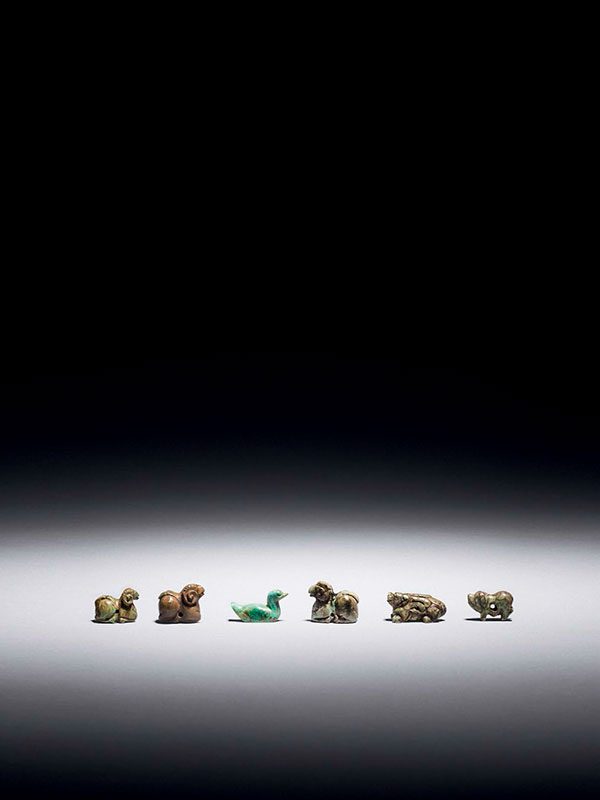Group of six turquoise animal carvings
A group of six miniature animals carved from turquoise matrix, comprising a duck, a pig, three rams, and a one-horned mythical beast, bixie. The animals are realistically carved and each animal is drilled through. The colour of the turquoise stone rangesfrom a light blue to a pale green, mottled with metallic grey colour.
The drill holes in these exquisitely carved animals indicate that they were made as beads, perhaps for the type of elaborate pectoral that was popular at thetime. Kneeling sheep in Chinese culture are considered symbols of filial children by Confucians.[1] Two comparable miniature animals, including a ram and a duck made of black amber, were part of a string of beads excavated from a WesternHan dynasty tomb at Yaozhuang, Yangzhou, Jiansu province, and are now in the collection of the Yangzhou Museum.[2] Turquoise has been used in personal ornaments since the Shang period (16th century – c. 1046 BC), and continued to enjoy popularity during the Han dynasty. Some turquoise beads in the shape of miniature birds and animals were excavated from Jinning, Yunnan province and are now in the collection of the Yunnan Provincial Museum.[3] Two closely comparable turquoise miniature rams dated to the Han dynasty are in the Kwan collection, Hong Kong.[4] Examples of two rams and a pig, made of agate and dated to the Han dynasty, are in the Liu Family collection.[5] Another example of a mythical beast bixie is in the collection of the Museum of East Asian Art, Bath, where it is dated by McElney and Forsyth to the early Six Dynasties (220 – 420 CE).[6]
- Welch, P. B. Chinese Art – A Guide to Motifs and Visual Imagery, Tuttle Publishing,Singapore, 2012, p. 132
- Gu, Fang ed. Complete Collection of Unearthed Jades in China- vol. 7 Jiangsu & Shanghai, Ke xue chu ban she, Beijing, 2005, p. 142
- Gu, Fang ed. Complete Collection of Unearthed Jades in China- vol. 12 Yunnan, Guizhou& Xizang, Ke xue chu ban she, Beijing, 2005, p. 86
- Yang, Boda, Chinese Archaic Jades from the Kwan Collection, Art Gallery of Chinese University of Hong Kong, 1994, no. 221
- Yun, Xizheng, ‘Liu Family’s Collection (II)- Chinese Ancient Crystal and Agate Ware’,in Collectors, Beijing, 2012 (10), figs. 24, 25, 26, p. 15
- Forsyth, A. and McElney, B. Jades from China, The Museum of East Asian Art, Bath,1994, no. 168, p. 267
綠松石迷你獸形珠六件
漢 西元前206年 – 西元220年
長:1.5 – 2 公分
綠松石迷你珠飾六件,包含一水鴨、一臥豬、三臥羊及一獨角辟邪。綠松石顏色原閃綠鮮豔,部分沁為
灰綠色,並含深棕色細絲。每隻動物造像栩栩如生,細節刻飾入微,體中橫穿小孔,便於繩線穿繫,以
為配飾。臥羊於中國儒家思想中,象徵兒孫孝順。江蘇省揚州市邗江區甘泉姚庄101墓出土九件西漢迷
你串飾,包含以煤精製成的迷你鴨及臥羊各一,型態與本品類似,現藏於揚州博物館。綠松石配飾在商
代即已發現,至漢代仍盛行,尤以雲南滇文化為代表。雲南省晉寧縣石寨山13號墓出土四件西漢綠松
石迷你鳥獸形珠,現藏於雲南省博物館。香港關氏藏有漢代迷你綠松石羊兩件,形制與雕刻與本品極為
相似,載於香港中文大學文物館出版《關氏所藏古玉》。

